Historic Army SM-1 Nuclear Plant in Photos
It was released this week that the US Army Corps of Engineers has decided to enter into the process of decontaminating and dismantling the historic SM-1 nuclear plant at Fort Belvoir, Virginia. This early military prototype plant isn't often discussed or even remembered today, so let's look at the history of this project through photos.
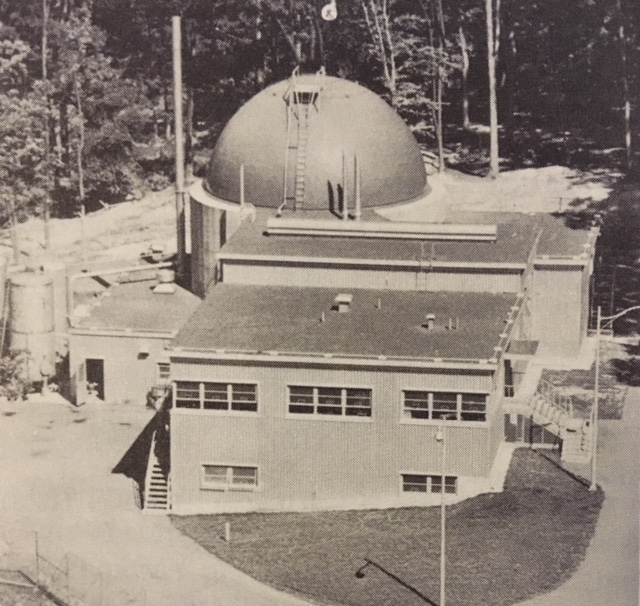
APPR, later redesignated as the SM-1.
After having been tasked by the US Atomic Energy Commission in 1952 with exploring uses of atomic energy, the US Army paired its Army Corps of Engineers with Oak Ridge National Laboratory to design a conceptual nuclear plant which, small in output, could be transported anywhere by airplane and then constructed and operated. In 1954, ALCO Products, formerly one of the world's largest railroad locomotive builders (its name was a contraction standing for American Locomotive Company) decided to form a nuclear power department and get into the business. Amazingly, when the AEC and US Army decided to go ahead with the packaged reactor project that year ALCO got the contract - although it was said at the time to have been a case of underbidding on the part of ALCO to ensure it could get a foot in the door in this new business. Construction partner on the project was Stone & Webster Engineering (which itself bid a $1 fee for engineering the Shippingport Atomic Power Station for exactly the same reasons ALCO bid low on this project.) The designation for this project was to "APPR," or Army Packaged Power Reactor.
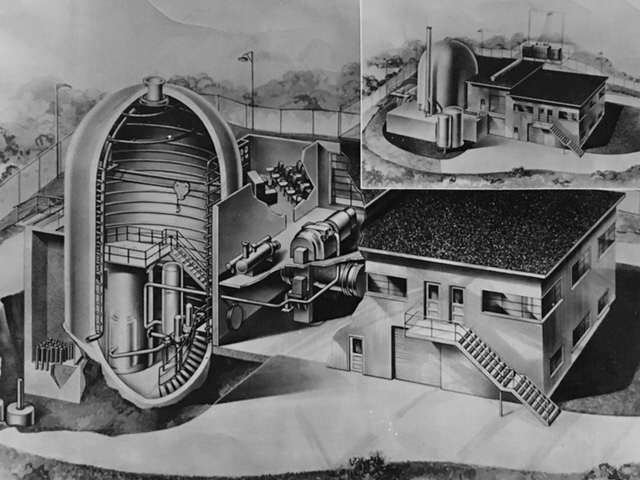
This is an extremely rare ALCO Products press photo from my collection. The original caption is as follows: "First views approved for publication of the Army Package Power Reactor designed by American Locomotive Company under a contact received from the Atomic Energy Commission in December, 1958. The APPR will be a prototype of the first atom-powered generating plant built so that its components can be transported by air to remote bases in any part of the world. The US Army's first atomic reactor will be erected at Ft. Belvoir, Va., headquarters of the Army Corps of Engineers, and should be in operation in about three years. It will probably be the nation's first exportable peaceful application of atomic energy. According to Adm. Lewis L. Strauss, chairman of the AEC, the contract is the first of its kind to be let on a fixed-price basis and as such is an important step in the development of power reactor technology. ALCO was successful bidder among 18 companies seeking the contract, which will be administered by Schenectady Operations of the AEC.
The design developed for the APPR centered around a small, highly enriched 10,000 Kwt reactor using plate type fuel, which supplied heat to a single U-tube type steam generator. The plant's intent was to furnish both electric power and space heat for remote installations (such as research or remote radar or weapons stations), but since Fort Belvoir required no space heat a 2000 Kwe turbine generator was installed to absorb the small plant's entire output. The plant was then rated 1855 Kwe net, which was supplied to the local Fort Belvoir base grid.
Construction of the plant began under the $3,500,000 fixed price contract on October 5, 1955; the plant was first started up less than two years later, on April 8, 1957.
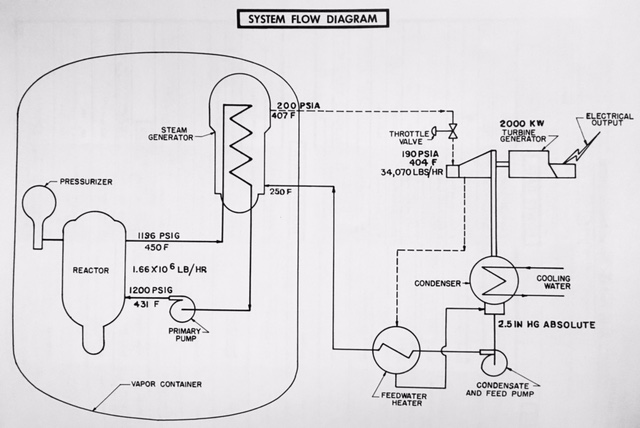
System diagram giving significant parameters for this diminutive, single loop PWR plant. The reactor vessel was just about 47 inches inside diameter and was fabricated of carbon steel with a 304 stainless welded overlay in ALCO's own shops. The steam generator, designed to provide slightly superheated steam, had to be partially dismantled and fitted with different internal equipment after early plant testing revealed operating deficiencies. After this, the equipment performed to specification.
After achieving full power operation on April 20, 1957 the plant was placed in full operation, both conducting various physics and core tests and, very importantly, acting as a working nuclear power classroom for many students of all branches of service and even for civilians. The design led to a small family of portable PWR reactors and plants; several were built and operated with mixed success.
Operationally the plant, which in 1959 was redesignated from APPR to SM-1 to match new Army parlance, proved to be very impressive. The plant demonstrated an ability to ride out a full load rejection without scramming simply by reducing fission rate on moderator temperature alone. It also showed that the nuclear portion of the plant could respond to load change at any rate that the throttle equipment of the turbine generator could apply. Truly, the consortium of the Corps of Engineers, ALCO, and Oak Ridge had developed a remarkable plant - a plant whose characteristics are being called for again even now in 2019.
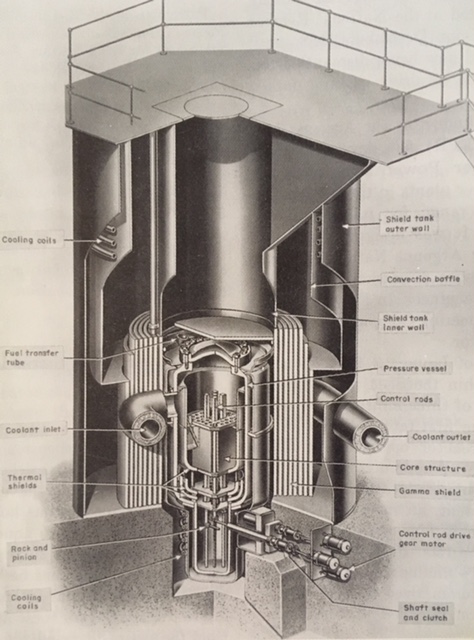
Arrangement of SM-1 equipment inside the primary shield.
The plant continued to be operated by ALCO for three years, being refueled for the first time in April 1960. ALCO's contract ended and control of the project was given to the Army Corps of Engineers in July, 1960 who would retain operating responsibility permanently. During these early changes and the succeeding several years various further tests were carried out, although as time wore on the reduction of funding to the Army's nuclear program overall tended to steadily reduce any testing or experimentation. The plant's original analog Oak Ridge vacuum tube I&C equipment had proven somewhat troublesome (the reactor scramming more often than desirable on spurious period scrams, for example) and one major investment was made in 1963 to solve this when General Electric solid state I&C equipment was installed.
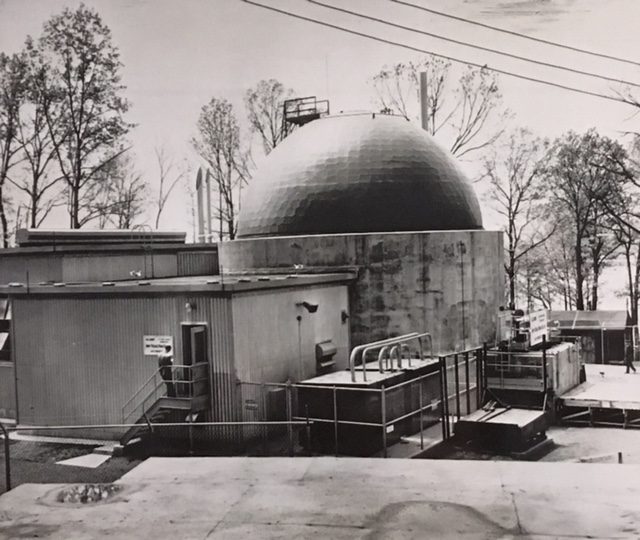
The compact SM-1 plant is quickly recognizable in photos not just because of the rather unique plant building layout but also because of the 3 foot thick shielding concrete belt outside the containment. The containment, a steel cylinder topped and based with hemispheres, is 64 feet high and 36 feet wide. It also has another two feet of shielding concrete inside.
By the early 1970's the Army had little further use for atomic energy, having had its remote operating plans more or less cancelled by the rapid development of other technologies. (For example, the shift to ballistic missiles had rendered the DEW Line, or Defense Early Warning system, obsolete; it was replaced by the BMEWS or Ballistic Missile Early Warning System that didn't need remote radar stations dotting the arctic.) The decision was made to shut down the SM-1 in 1973; the plant was defueled and placed in storage, awaiting the day when it would finally be dismantled. With the recent moves by the Army Corps of Engineers, it appears that this day is approaching; it's good, then, to remember this historic, early plant and its contributions. It's also sobering to think that a portable, load following unitized plant being asked for in some quarters today was already built a half century ago and worked extremely well.
In addition to press photos and materials, sources for the above article include:
Annual Report to Congress of the Atomic Energy Commission, 1964.
The Atomic Energy Deskbook, John F. Hogerton; Reinhold Publishing, New York, 1963.
Nuclear Reactor Plant Data, Volume One - Power Reactors; American Society of Mechanical Engineers, 1958.
Nucleonics, February 1959 and May 1959.
Feel free to include a constructive comment for the author below.
 Will Davis is a member of the Board of Directors for the N/S Savannah Association, Inc. He has been a contributing author for Fuel Cycle Week, and he used to write his own popular blog Atomic Power Review. Davis is also a consultant and writer for the American Nuclear Society, and serves on the ANS Communications Committee and the Book Publishing Committee. He is a former U.S. Navy reactor operator and served on SSBN-641, USS Simon Bolivar. His popular Twitter account, @atomicnews is mostly devoted to nuclear energy. He has an Instagram at @williamdavis5500, but that's mostly dog photos.
Will Davis is a member of the Board of Directors for the N/S Savannah Association, Inc. He has been a contributing author for Fuel Cycle Week, and he used to write his own popular blog Atomic Power Review. Davis is also a consultant and writer for the American Nuclear Society, and serves on the ANS Communications Committee and the Book Publishing Committee. He is a former U.S. Navy reactor operator and served on SSBN-641, USS Simon Bolivar. His popular Twitter account, @atomicnews is mostly devoted to nuclear energy. He has an Instagram at @williamdavis5500, but that's mostly dog photos.
*Note: This story was updated on June 29, 2022, based on feedback from an ANS member.

